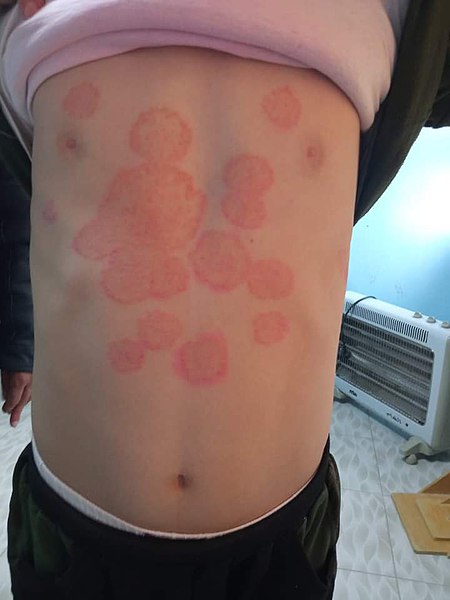Playlist
Show Playlist
Hide Playlist
Tinea Corporis (Ringworm) on Darker Skin: Epidemiology and Etiology
-
Slides Tinea Corporis Ringworm on Darker Skin Epidemiology and Etiology.pdf
-
Download Lecture Overview
00:00 Welcome to our lecture on Dermatophyte infections of the skin. 00:06 First, let's take a look at tinea corporis. 00:10 This is epidermal dermatophyte infections on sites other than the feet, groin, face, or hand. It is caused most commonly by the fungus called Trichophyton rubrum. There are other causes like T tonsurans, Trichophyton mentagrophytes and Microsporum gypseum, and lastly Microsporum canis. 00:43 So how is this transmitted? This is transmitted through direct skin contact with an infected individual. 00:52 Secondary spread may also occur from other primary sites of dermatophyte infection, for example scalp and feet. 00:59 That is, if somebody has the same fungal infection in other areas. 01:06 In an early lesion of tinea corporis, one has a pleuritic circular or oval, erythematous or hypopigmented scaling patch, or a plaque that spreads centrifugally so the center clears and the lesion spreads on the periphery. 01:25 Late lesions may present as annular plaque where one sees central clearing with an active advancing raised border. 01:36 Some patients may also present with extensive lesions, particularly in immunocompromised patients, for example HIV Aids, diabetes mellitus, or patients who are on topical or systemic steroids. 01:52 So what's a differential of tinea corporis? This can be easily confused with subacute cutaneous lupus. 01:59 Of course, the patient may also have other symptoms or signs. 02:03 Granuloma annulare is another common differential of tinea corporis. 02:11 And lastly, erythema annulare centrifugum, where you see the erythematous in light skin erythematous edge that spreads, you know, annually and outwards.
About the Lecture
The lecture Tinea Corporis (Ringworm) on Darker Skin: Epidemiology and Etiology by Ncoza Dlova is from the course Fungal Skin Infections in Patients with Darker Skin.
Included Quiz Questions
Which fungus is the most common causative agent of tinea corporis?
- Trichophyton rubrum
- Microsporum canis
- Trichophyton tonsurans
- Microsporum gypseum
- Trichophyton mentagrophytes
What is the characteristic appearance of a late lesion in tinea corporis?
- An annular plaque with central clearing and an active advancing raised border
- A vesicular eruption with central pustules and peripheral scaling
- A hyperpigmented macule with irregular borders and satellite lesions
- A papulosquamous eruption with central hyperkeratosis and minimal erythema
- A bullous lesion with central necrosis and peripheral erythema
Customer reviews
5,0 of 5 stars
| 5 Stars |
|
5 |
| 4 Stars |
|
0 |
| 3 Stars |
|
0 |
| 2 Stars |
|
0 |
| 1 Star |
|
0 |




